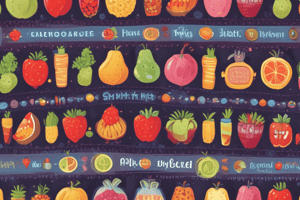Podcast
Questions and Answers
Which of the following factors can increase the glycemic index (GI) of a food?
Which of the following factors can increase the glycemic index (GI) of a food?
- Higher fiber content
- Increased processing (correct)
- Raw state
- Higher fat content
Cooking and processing foods generally reduce their glycemic index (GI).
Cooking and processing foods generally reduce their glycemic index (GI).
False (B)
What types of food generally have a lower glycemic index?
What types of food generally have a lower glycemic index?
Raw foods
Foods with increased fat and fiber content require more time for ______ and delay gastric emptying.
Foods with increased fat and fiber content require more time for ______ and delay gastric emptying.
Which food is likely to have a higher glycemic index?
Which food is likely to have a higher glycemic index?
Match the following types of food with their typical glycemic index classification:
Match the following types of food with their typical glycemic index classification:
What is one limitation of using glycemic index (GI) as a guide for food choices?
What is one limitation of using glycemic index (GI) as a guide for food choices?
What is the primary role of insulin after consuming a carbohydrate-rich meal?
What is the primary role of insulin after consuming a carbohydrate-rich meal?
High-glycemic foods raise blood glucose levels slowly compared to low-glycemic foods.
High-glycemic foods raise blood glucose levels slowly compared to low-glycemic foods.
What is the term used to measure the effects of a carbohydrate-containing food on blood-glucose levels?
What is the term used to measure the effects of a carbohydrate-containing food on blood-glucose levels?
Foods with a glycemic index categorized as high GI are those with a value of _____ or higher.
Foods with a glycemic index categorized as high GI are those with a value of _____ or higher.
Match the following foods with their glycemic index category:
Match the following foods with their glycemic index category:
Which of the following is the glycemic index of plain yogurt?
Which of the following is the glycemic index of plain yogurt?
A diet consisting of low-GI foods can increase the risk of Type 2 diabetes.
A diet consisting of low-GI foods can increase the risk of Type 2 diabetes.
Name one low-glycemic food from the provided list.
Name one low-glycemic food from the provided list.
Flashcards are hidden until you start studying
Study Notes
Insulin and Glucose Storage
- Insulin is the hormone that helps the body use glucose.
- When there is an abundance of glucose in the blood, insulin signals cells to absorb it and either use it or store it.
- Excessive glucose, protein, and lipids are stored as fat.
Glycemic Index (GI)
- GI measures the effects of carbohydrate-containing foods on blood-glucose levels.
- Foods are ranked based on their GI compared to a reference food (white bread or glucose).
- Low GI foods raise blood glucose levels slower and less than high GI foods.
Low GI Foods (< 55)
- Apple, raw
- Orange, raw
- Banana, raw
- Mango, raw
- Carrots, boiled
- Taro, boiled
- Corn tortilla
- Spaghetti (whole wheat)
- Baked beans
- Soy milk
- Skim milk
- Whole milk
- Yogurt, fruit
- Yogurt, plain
- Icecream
Medium GI Foods (56–69)
- Pineapple, raw
- Cantaloupe
- Mashed potatoes
- Whole-wheat bread
- Brown rice
- Cheese pizza
- Sweet potato, boiled
- Macaroni and cheese
- Popcorn
High GI Foods (70 and higher)
- Banana (over-ripe)
- Corn chips
- Pretzels
- White bread
- White rice
- Bagel
- Rice milk
- Cheerios
- Raisin Bran
- Fruit roll-up
- Gatorade
Factors Affecting GI
- Fat and fiber content: Increased fat and fiber delay digestion and reduce GI.
- Processing and cooking: Processing and cooking increase digestibility and raise GI.
- Ripeness: Ripening fruits and vegetables increases their GI.
GI Limitations
- GI does not consider the amount of carbohydrates in a portion of food.
- Combining foods with different GIs impacts the overall GI of a meal.
- Nutrient-dense foods may have higher GIs than less nutritious foods.
- Meats and fats do not have a GI as they do not contain carbohydrates.
Studying That Suits You
Use AI to generate personalized quizzes and flashcards to suit your learning preferences.




